 Maryland's state parks grew out of the state's early efforts at forest conservation. By 1912, a portion of the Patapsco Forest Reserve had been developed and dedicated specifically for public recreational use, and as early as 1910 this parcel had been referred to as "Patapsco Park." |
 Fred W. Besley embodied the conservation ethic of his time. A protégé of Gifford Pinchot, Besley held a master's degree from Yale University's School of Forestry, the nation's first forestry school. Besley served with distinction as Maryland's state forester from 1906 until 1942. |
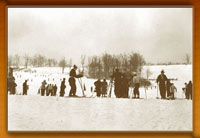 The New Germany area in Savage River State Forest became Maryland's first genuine winter sports resort. Carload after carload of cross country and downhill skiers flocked to New Germany, which boasted overnight accommodations for as many as eighty visitors - some in rustic summer cabins, and others in the homes of nearby farm families. Enjoy a day of ski racing in 1941 at New Germany's Whiskey Hollow Trail. |
 Nursery operations at the State Forest Tree Nursery originated in 1914, where trees were first grown for roadside planting. The nursery later expanded to grow seedlings for conservation purposes including wildlife habitat, watershed and soil protection and forest products. The nursery moved to Anne Arundel County in 1949 and in 1996 to its site near Preston. |
 By 1916, the scenically beautiful Patapsco had over 200 campsites. As other State Forest Reserves became available to the public, campers and day visitors enjoyed picnics, horseback riding, fishing, hiking and even skiing on Maryland's new public lands. Swimming at Patapsco and bathing in a pool below Muddy Creek were also popular. |
 Youth groups including 4-H Clubs, Boy Scouts, YWCAs, and others are an integral part of the history of conservation in Maryland. They gathered pine cones to harvest seeds for the State's first tree nursery, volunteered to help plant trees (just like kids do today), built bridges & trails, and learned to enjoy Maryland's public forests and parks. |
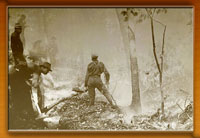 One of State Forester Besley’s first tasks was to create a network of volunteer Forest Wardens to enforce Maryland’s new forest fire protection laws. At the turn of the century uncontrolled fires took their toll, regularly leading to loss of life and property. Early forest wardens were trained and deployed to combat wildfires in an effort to protect the public and ensure that millions of seedlings being planted would survive. |
 The C.C.C. was a massive Federal works program during the Great Depression. In Maryland, the C.C.C. put a total of 30,000 young men to work reclaiming natural resources and building facilities for public accommodation in the out of doors. C.C.C. crews built lakes, cabins, pavilions, trails, campgrounds and other visitor amenities all over the state, though principally on State Forest lands in Western Maryland. |
 Wood manufacturing in Maryland began with hundreds of small sawmills that often used streams and water wheels to power they belt-driven machinery. Modern milling technology uses computers to scan logs and determine how best to maximize wood recovery and optimize grade and quality. Modern wood-producing mills make use of every part of a tree in a very efficient manufacturing process. |
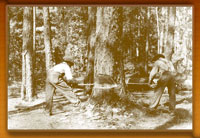 A hundred years ago the most common forestry tools consisted of a compass, a Biltmore stick, a hatchet, and a two-man cross-cut saw or "misery whip" as it was known to its operators. Today, natural resource professionals have progressed far beyond simple hand tools to mechanized harvesting equipment, laser range finders, global positioning systems, and computer mapping. |
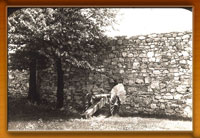 |
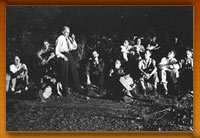 |
Fort Frederick, erected by Governor Horatio Sharpe in 1756 to protect English settlers from the French and their Indian allies has a long and interesting history. In 1922, under Fred W. Besley's guidance, the state purchased the fort to develop a state park. During the 1930's, a company of the Civilian Conservation Corps was assigned to the park to reconstruct the dilapidated stone wall, perform archaeology and locate the foundations of the original interior buildings. | In the spring of 1941, members of the Mountain Club of Maryland made several visits to Green Ridge State Forest, where they helped build and maintain the Paw Paw Shelter on the slope of Town Hill Mountain. Our 1st State Forester, Fred W. Besley, signed a lease to the shelter and entertained around their campfire. The club, which held a dedication hike on June 22, 1941, remains active today. |